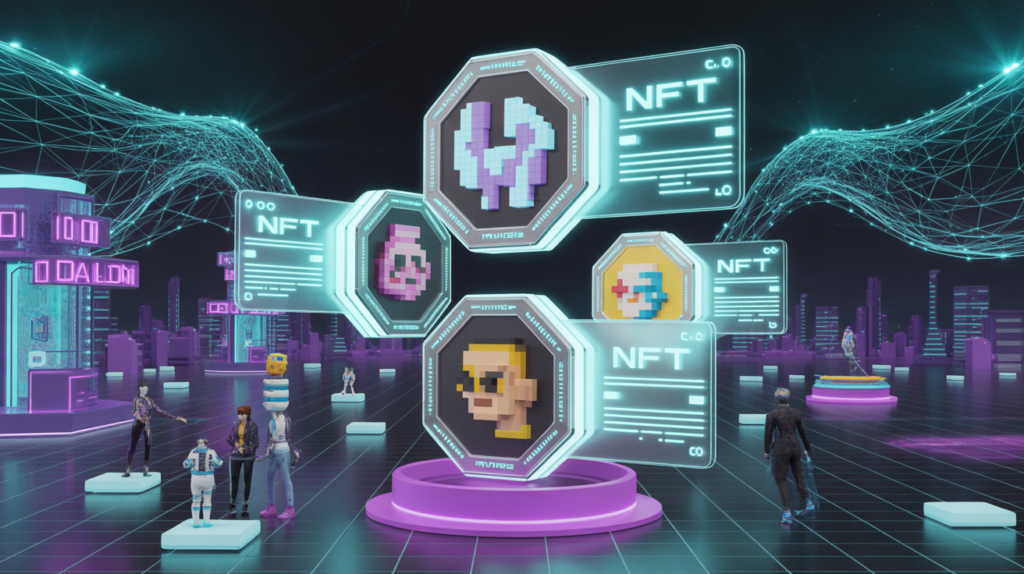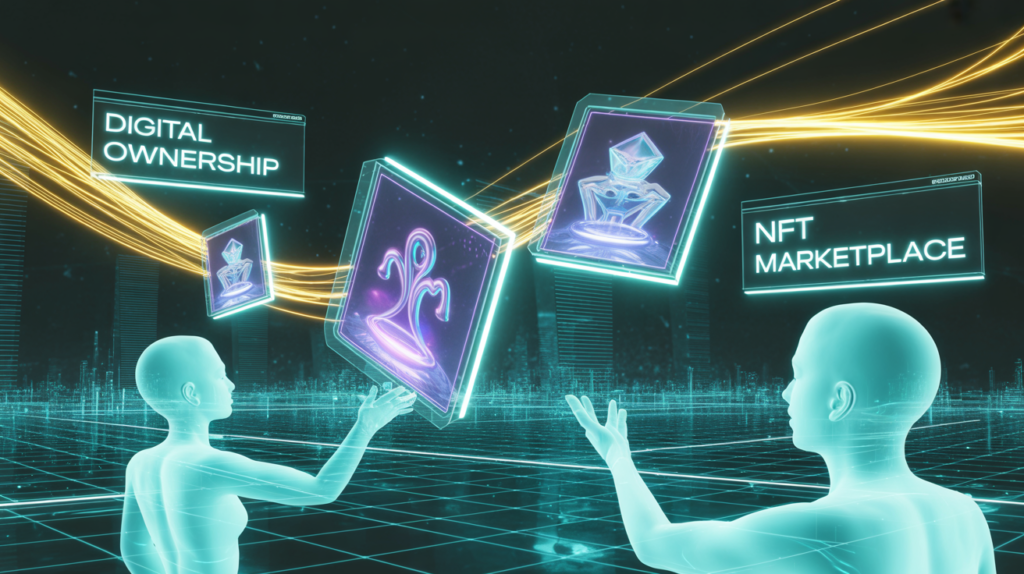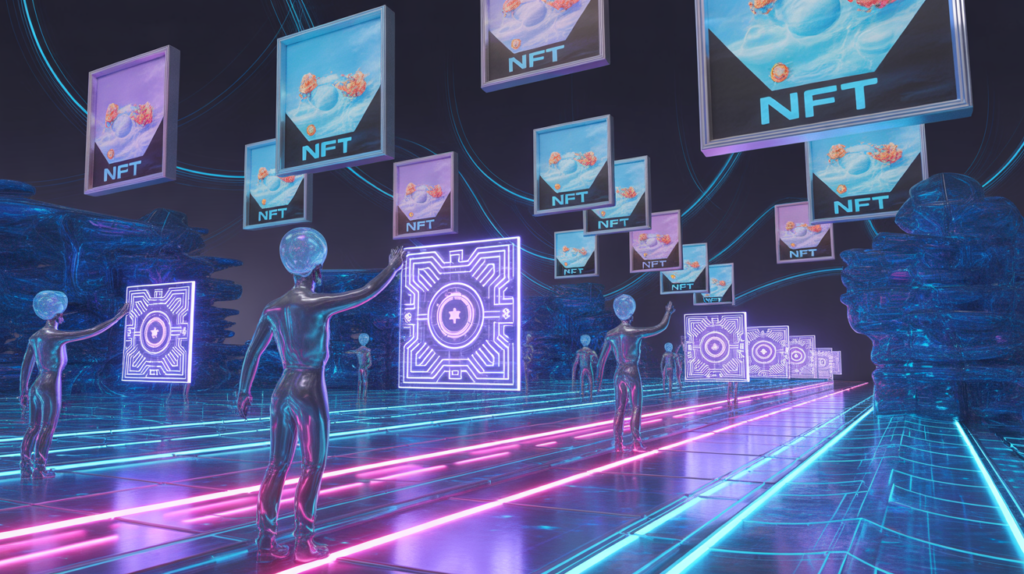Table of Contents
ToggleNFTs and the Metaverse: Discover the Inspiring Future of Digital Ownership
In the last few years, few technologies have captured global imagination like NFTs and the Metaverse. Together, they are redefining how we create, buy, and experience digital assets — shaping the next frontier of digital ownership, identity, and value.
For decades, we’ve lived online — but never truly owned anything there. Social media posts, in-game items, even virtual art — all technically belong to centralized platforms. That’s changing now. With blockchain, NFTs and the Metaverse are building a decentralized economy where users can finally own their digital worlds.
Understanding NFTs and the Metaverse
What Are NFTs?
Non-Fungible Tokens (NFTs) are digital assets that represent unique ownership on the blockchain. Each NFT is one-of-a-kind, verified, and impossible to replicate. They can represent art, collectibles, virtual real estate, music, or even identity.
Unlike cryptocurrencies such as Bitcoin, which are interchangeable, NFTs are distinct and provably scarce. This uniqueness gives them real-world value — especially in virtual environments like the Metaverse.
What Is the Metaverse?
The Metaverse is a vast, interconnected virtual universe — an immersive digital ecosystem where people socialize, work, play, and trade using digital avatars. It blends virtual reality (VR), augmented reality (AR), and blockchain to create persistent, shared spaces.
Platforms like Decentraland, The Sandbox, and Meta Horizon Worlds have already begun turning this vision into reality. Within these spaces, NFTs and the Metaverse interact seamlessly — allowing users to buy land, own virtual homes, wear digital fashion, and even host events that generate income.
How NFTs Power the Metaverse Economy
In simple terms, NFTs are the backbone of digital ownership inside the Metaverse. They provide proof that an asset — a plot of land, an avatar skin, or an artwork — truly belongs to you.
Here’s how they work together:
1. Digital Real Estate
Virtual lands in the Metaverse are bought and sold as NFTs. Platforms like The Sandbox and Decentraland have seen properties sell for millions. Owners can build storefronts, galleries, or entertainment hubs, just as they would in the physical world.
NFTs provide the deed of ownership, while blockchain ensures it can’t be forged or stolen.
2. Virtual Fashion and Identity
Avatars in the Metaverse wear clothes, accessories, and even hairstyles — all sold as NFTs. Luxury brands like Gucci, Adidas, and Dolce & Gabbana have already launched digital collections.
This makes fashion in the Metaverse more than style — it’s a status symbol, investment, and social identity.
3. Digital Art and Collectibles
Art galleries in the Metaverse display NFT artworks that can be purchased directly from creators. Artists benefit from global exposure and royalty features, ensuring they earn revenue every time their work is resold.
This mechanism is transforming creative economies worldwide.
4. Gaming and Interoperable Assets
In gaming, NFTs allow true ownership of in-game assets — swords, skins, or vehicles that players can trade across different games. This interoperability is crucial for building an open, connected Metaverse.
Games like Axie Infinity and Illuvium have proven how valuable virtual ownership can be.
The Economic Impact of NFTs and the Metaverse
Market Growth and Opportunities
According to recent industry data, the global NFT market surpassed $40 billion in 2024, and the Metaverse economy is expected to exceed $800 billion by 2030.
For U.S. investors and global creators, this represents an unprecedented opportunity to participate in the future of online economies.
At analysts track emerging trends in NFTs and the Metaverse, highlighting how blockchain adoption is influencing art, real estate, and digital commerce across multiple industries.
The Role of Web3
The rise of Web3 — a decentralized version of the internet — is making ownership transparent and equitable. With NFTs and the Metaverse, users no longer rent digital space; they own it, trade it, and profit from it.
This ownership shift is fueling innovation, entrepreneurship, and new business models — from NFT-based ticketing systems to virtual brand experiences.
Challenges Facing NFTs and the Metaverse
Even as the excitement grows, challenges remain:
1. Scalability and Environmental Concerns
NFT minting once raised energy concerns, especially on early Ethereum networks. However, with the Ethereum Merge and new Layer-2 solutions, energy usage has dropped dramatically.
2. Regulation and Legal Ownership
As governments catch up, defining what constitutes “ownership” in the virtual world is crucial. Who enforces contracts? How are taxes applied? Legal clarity will shape the next phase of adoption.
3. Security and Scams
Phishing, rug pulls, and fake NFT projects still exist. Users must remain vigilant and trade only on verified platforms — a practice emphasized by experts at, which provides trusted crypto and NFT market insights.
4. Accessibility and Cost
Owning prime virtual real estate or exclusive NFTs can be expensive. As technology matures, platforms must become more affordable and inclusive to achieve mainstream adoption.
The Future of Digital Ownership
NFTs as Identity and Utility
In the near future, NFTs won’t just represent art or land — they’ll represent identity, credentials, and access. Imagine logging into virtual workplaces or online universities using NFT-based ID tokens that verify who you are.
The Rise of the Creator Economy
Creators will lead the Metaverse revolution. Artists, musicians, game designers, and even educators can tokenize their work, ensuring fair royalties and direct engagement with their audiences.
Interoperable Worlds
Different Metaverse platforms will soon connect, allowing users to carry their NFTs across multiple digital spaces. You’ll be able to wear your NFT sneakers in Decentraland, then showcase them in Meta Horizon or Roblox — blurring the line between platforms.
AI and Automation in Ownership
Artificial Intelligence is entering the picture too. AI-powered NFTs can evolve, learn user behavior, and adapt over time — creating a dynamic layer of personalization and long-term engagement within the Metaverse.
Why NFTs and the Metaverse Matter
At their heart, NFTs and the Metaverse are about freedom — creative freedom, financial freedom, and social freedom. They return control of digital property to individuals, giving artists, gamers, and entrepreneurs equal footing in a global, borderless economy.
As our lives become increasingly digital, ownership will define our identity. The blockchain ensures that what’s yours online truly belongs to you — permanently, transparently, and securely.
And with media outlets like BTCMARKETNEWS providing credible updates and expert insights, users can stay informed about new market trends, platform launches, and emerging technologies shaping the future of digital ownership.
🧠 FAQs About NFTs and the Metaverse
Q1: How are NFTs used in the Metaverse?
NFTs are used as proof of ownership for digital items like land, fashion, art, and gaming assets within the Metaverse. They verify authenticity and enable trading across virtual worlds.
Q2: Are NFTs and the Metaverse connected to cryptocurrency?
Yes. Both rely on blockchain technology. Most NFT transactions use cryptocurrencies like Ethereum or Polygon-based tokens for buying and selling.
Q3: What are the biggest risks of investing in NFTs and the Metaverse?
Risks include volatility, scams, and project failures. Always research teams, audit smart contracts, and follow trusted sources such as for verified insights.
Q4: Can I make money in the Metaverse with NFTs?
Absolutely. You can earn by selling NFT art, renting virtual property, trading assets, or creating digital experiences. However, success requires strategy, creativity, and patience.
Q5: What does the future hold for NFTs and the Metaverse?
The future points to full integration of blockchain, AI, and immersive VR — creating digital ecosystems where ownership, identity, and creativity thrive together.
Conclusion
The convergence of NFTs and the Metaverse marks a revolutionary step toward true digital ownership. It’s more than technology — it’s a cultural shift redefining how we value art, property, and identity in the online world.
With innovation accelerating and regulation catching up, the next few years will determine how deeply these technologies shape our daily lives.
One thing is certain: the digital world is no longer just a space we visit — it’s a world we can own.



